Project Scenario
Calendar Project (Note: The companies and people within the scenario are fictional.)
There has been a reduction in fie number of orders at the MNO Manufacturing Company due in part to the increased marketing activities of its competitors. To help counter this, the company has decided to create a promotional calendar for next year for all its current and prospective customers. The end product of this project will be a prepared calendar pack, ready for printing. The design of the calendar will be similar to one sent out previously, and must reflect the company image as described in the existing corporate branding standards. Another project is currently producing a new company logo when is to be printed on each page of the promotional calendar. The prepared calendar pack will consist of:
The project is currently in initiation and will have two further stages:
Stage 2 will include tie activities to:
Stage 3 will include the activities to:
A production cost forecast, based on the options and costs for the paper, envelope, printing and marketing of the calendar is to be produced in stage 2. However, the actual production and distribution of the calendars is not within the scope of the project. The product cost forecast will be reviewed by the Project Board to determine whether tie project should continue.
It is now 05 October and the prepared calendar pack must be delivered to the print company by 30 November, to enable printing and distribution of the calendar in time for Christmas. The cost of the activities to develop the specialist products and the cost of the project management activities are estimated to be £20,000. There is a project time tolerance of +1 week /-2 weeks and a project cost tolerance of +£6,000 / -£6,000. A change budget of £500 has been allocated but there is no risk budget.
The team member collating the list of customers has now forecast that it will NOT be complete by the end of this stage as originally planned, due to a number of new prospective customers' details not yet being available. What action should the team member take?
Who is responsible for reviewing the risk management practices to ensure they are in line with the project's risk management strategy?
Which of the following management products ARE updated as part of Managing a stage boundary?
1. Business Case
2. Benefits Review Plan
3. Configuration Item Records
4. Project Brief
The Manage by Exception principle sets tolerances for six areas of the project, Time. Cost and Quality are three of them, what are the other three?
Scenario:
Techniques, processes and procedures
1. Any threat that may result in a loss of MFH data must be escalated immediately.
Joint agreements
2. Work is to start at the beginning of week 2 (Stage 4).
3. The project will take two years to complete, at an estimated cost of £2.5m.
Tolerances
4. None.
Constraints
5. MFH staff must not be involved in any heavy lifting during the removal of existing IT equipment.
6. Installation work must take place during MFH normal working hours.
7. +£10,000 / -£25,000.
Reporting arrangements
8. Highlight Report every Monday by 10.00 am.
9. The report must contain a summary of all products worked on during the previous week.
10. Project Manager must be notified of any issues immediately by telephone.
Problem handling and escalation
11. Impact analysis of all issues must be completed within 24 hours.
Extracts or references
12. The Stage Plan for stage 4 is available from Project Support.
Approval method
13. Project Assurance will review the completed Work Package and confirm completion
Which 2 statements apply to either the Techniques, processes and procedures or Constraints sections?
Scenario
Additional Information
During the initiation stage the Project Manager met with the Marketing Director to find out more about the requirements of the promotional calendar and recorded the following notes:
There has been a reduction in the order numbers at the MNO Manufacturing due in part to the increased marketing activities of its competitors. 10% of customers have not re-ordered in this financial year and staff morale is poor. A number of skilled staff have left as a result and replacement staff have not been recruited due to the reduced operation. If the project is successful, a recruitment campaign will be required to fill the existing staff vacancies and there may be a requirement for additional staff. Operational costs are likely to increase because skilled staff are expensive and difficult to find.
In financial terms, there were a total of 1,500 orders in the last financial year, each with an average profit of £2k. The Marketing department believes that sending a promotional calendar to our current and prospective customers would increase orders by at least 10% with a minimum of 10 further orders from the list of prospective customers within 12 months from the date of distribution.
The Marketing Director will be funding the project from the business marketing budget. She believes that the effect of a good company image portrayed by a successful calendar would last into a second year. She has forecast the same increase in orders for a second year and predicts that the annual employee satisfaction survey will show a measurable improvement in staff morale.
A number of alternatives were explored, including:
The calendar is seen as the favored option, as long as the company's competitors do not increase their marketing activity. Whilst the Marketing department wants a very high quality, glossy product, the project management team must be aware of the cost this will incur.
Using the Project Scenario and the additional Information provided for this question In the Scenario Booklet, answer the following question.
Which 2 statements should be recorded under the Reasons heading?
Scenario
Additional Information
During the initiation stage the Project Manager met with the Marketing Director to find out more about the requirements of the promotional calendar and recorded the following notes:
There has been a reduction in the order numbers at the MNO Manufacturing due in part to the increased marketing activities of its competitors. 10% of customers have not re-ordered in this financial year and staff morale is poor. A number of skilled staff have left as a result and replacement staff have not been recruited due to the reduced operation. If the project is successful, a recruitment campaign will be required to fill the existing staff vacancies and there may be a requirement for additional staff. Operational costs are likely to increase because skilled staff are expensive and difficult to find.
In financial terms, there were a total of 1,500 orders in the last financial year, each with an average profit of £2k. The Marketing department believes that sending a promotional calendar to our current and prospective customers would increase orders by at least 10% with a minimum of 10 further orders from the list of prospective customers within 12 months from the date of distribution.
The Marketing Director will be funding the project from the business marketing budget. She believes that the effect of a good company image portrayed by a successful calendar would last into a second year. She has forecast the same increase in orders for a second year and predicts that the annual employee satisfaction survey will show a measurable improvement in staff morale.
A number of alternatives were explored, including:
The calendar is seen as the favored option, as long as the company's competitors do not increase their marketing activity. Whilst the Marketing department wants a very high quality, glossy product, the project management team must be aware of the cost this will incur.
Using the Project Scenario and the additional Information provided for this question In the Scenario Booklet, answer the following question.
Which 2 statements should be recorded under the Business options heading?
Scenario
A photographer from Portraits Ltd, a professional photographic company, has taken on the role of Team Manager after taking some time to understand the requirements of the project. A contract for their services has been set up and is being monitored by the Purchasing Manager and a Work Package has been agreed. This contract specifies that the photographer must arrange a meeting with the Engineering Manager to establish a schedule for the photo sessions to minimize the impact on the Engineering staff. This meeting should have occurred by now.
The Engineering Manager was made aware of this requirement but when asked he reported that he has received no communication from the photographer. The Project Manager has tried to call the photographer and has had no response. The Project Manager believes there is a risk that Portraits Ltd are overbooking work and prioritizing other clients' work. If Portraits ltd do not deliver on schedule the project will be delayed and the expected benefits will be reduced.
The contract is to be reviewed and Portraits Ltd reminded of their agreement.
The project is now in stage 2. The Project Manager has heard about the possibility of a competitor also producing a calendar to be delivered earlier than the target date for this project. There is a threat that the early release of a competitor's calendar may weaken the impact of the MNO Manufacturing Company calendar, thereby reducing the anticipated benefits of the Calendar project.
Which 2 statements should be recorded under the Proximity heading?
Scenario
Additional Information
During the initiation stage the Project Manager met with the Marketing Director to find out more about the requirements of the promotional calendar and recorded the following notes:
There has been a reduction in the order numbers at the MNO Manufacturing due in part to the increased marketing activities of its competitors. 10% of customers have not re-ordered in this financial year and staff morale is poor. A number of skilled staff have left as a result and replacement staff have not been recruited due to the reduced operation. If the project is successful, a recruitment campaign will be required to fill the existing staff vacancies and there may be a requirement for additional staff. Operational costs are likely to increase because skilled staff are expensive and difficult to find.
In financial terms, there were a total of 1,500 orders in the last financial year, each with an average profit of £2k. The Marketing department believes that sending a promotional calendar to our current and prospective customers would increase orders by at least 10% with a minimum of 10 further orders from the list of prospective customers within 12 months from the date of distribution.
The Marketing Director will be funding the project from the business marketing budget. She believes that the effect of a good company image portrayed by a successful calendar would last into a second year. She has forecast the same increase in orders for a second year and predicts that the annual employee satisfaction survey will show a measurable improvement in staff morale.
A number of alternatives were explored, including:
The calendar is seen as the favored option, as long as the company's competitors do not increase their marketing activity. Whilst the Marketing department wants a very high quality, glossy product, the project management team must be aware of the cost this will incur.
Using the Project Scenario and the additional Information provided for this question In the Scenario Booklet, answer the following question.
Lines A to E in the table below consist of an assertion statement and a reason statement. For each line identify the appropriate option, from options A to E, that applies. Each option can be used once, more than once or not at all.
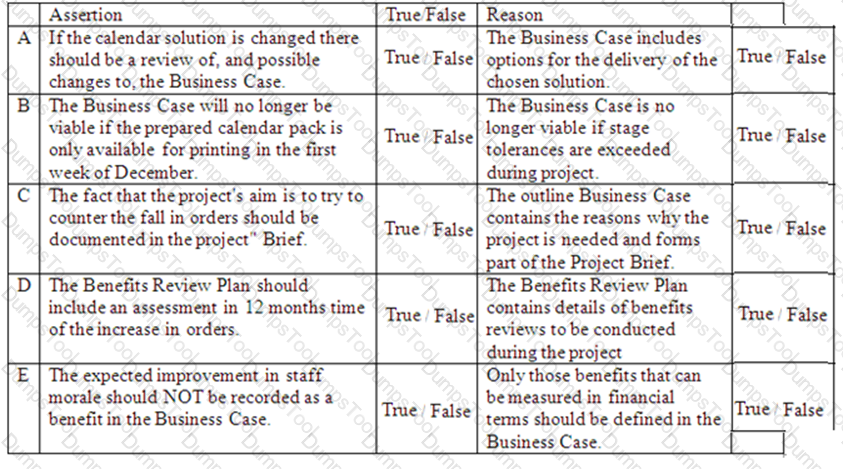
RISK
The following risk has been recorded:
“There may not be enough participants for the pilot courses to justify the continuation of the project.”
The recommended risk response is to improve the marketing campaign, and a risk budget exists to fund the response.
Here are three risk actions related to this response?
Which role (A-F) should be responsible for each action?
Choose only one role for each action. Each role can be used once, more than once, or not at all.
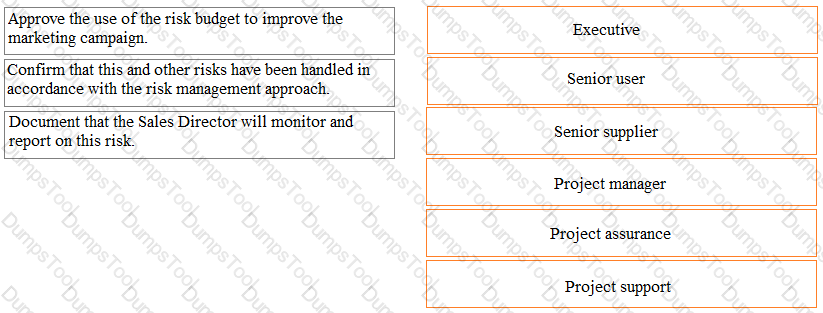
ORGANIZATION
Use the ‘Additional Information’ in the Scenario Booklet to answer this question.
Here are three individuals who work for ABC Company.
Which project management team role (A-F) would be the most appropriate for each individual?
Choose only one role for each individual. Each role can be used ONCE, or not at all.
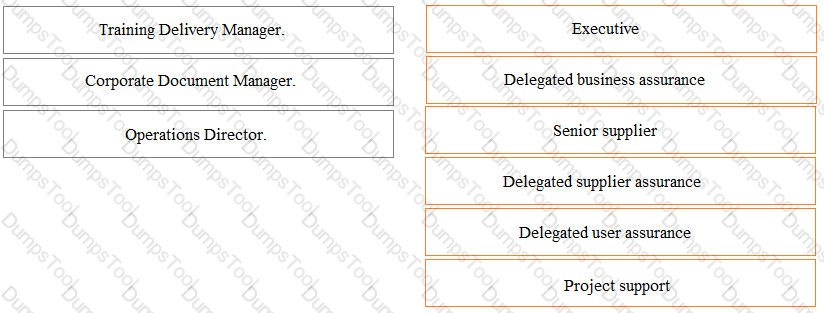
Project Scenario – Health and Safety Training Project:
ABC Company is a well-established training company that uses a standard model to develop training materials and deliver courses to customers.
ABC Company has commissioned a project in response to recent changes in government legislation relating to health and safety on construction sites. The project will deliver “capability to provide health and safety training”, including the materials needed for classroom-based training and e-learning. The expected benefits for construction companies include a reduction in lost days and legal costs due to accidents.
The e-learning course will be developed by a specialist external consultancy. The materials for classroom-based training will be delivered by ABC Company’s development team. All course materials will be piloted before they are used. ABC Company will deliver training to its customers and also hopes to sell the course materials to other training companies as part of their operational business. ABC Company will use their own sales and marketing departments to promote the courses.
The legislation requires construction companies to comply with the new legislation within two years. The course materials and trainers have to be accredited by a government agency before courses can be delivered. ABC Company is planning to deliver pilot courses within five months of starting the project.
The ABC Company standard development model for new courses recommends the following stages:
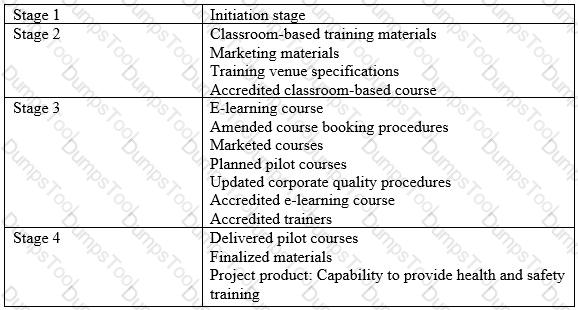
End of the Project scenario.
Additional Information:
The Chief Executive Officer (CEO) founded the company five years ago. Under her leadership, ABC Company has grown quickly into a successful training company. It delivers a range of accredited professional training.
The Finance Director is also a founder member of ABC Company and is responsible for authorizing budgets for the Operations and Development Teams. She authorizes all large contracts personally.
The Purchasing Manager reports to the Finance Director and is responsible for managing and monitoring supplier contracts.
The Operations Director is responsible for the delivery off all training and for the training development budget. His department organizes courses, venues and trainers. They work with the Product and the Sales teams to provide a comprehensive training schedule. ABC Company’s IT manager reports to the Operations Director.
The Business Development Director has recently been appointed to identify new training needs and propose new products. She will work with the Operations. Director to ensure a cost-conscious approach and that appropriate development technologies are used for the health and safety course.
The Training Development Manager reports to the Business Development Director and is responsible for developing training materials and gaining accreditation, in accordance with the standard course development model. Course developers in his team have skills in a range of development technologies and are allocated to projects as needed.
The Training Delivery Manager, who reports to the Operations Director, is responsible for ensuring that internal and external trainers deliver ABC Company training courses to the required standard. He also checks course materials to ensure they are fit for purpose and of the required quality.
The Central Services Director has responsibility for corporate communications, facilities management and configuration management. He recently led a project to consolidate all company quality systems into one quality management system and set up a corporate quality department, now managed by the Corporate Quality Manager.
The Corporate Document Manager reports to the Central Services Director. She helped establish the company’s document management system and now operates it across the business. She manages a team of administrators and contracts staff when workload is high.
The Sales Director joined ABC Company two months ago and is keen to establish himself by suggesting new markets for the courses and material. All account managers and the marketing team report to him. They promote existing training courses to other training companies and existing customers.
End of the additional information.
During the initiation stage, the project manager aligns the project's risk management approach to ABC Company's risk management policy. As a result, the project will use two risk registers, one for ABC Company's risks and one for external supplier risks.
Is this an appropriate application of the 'tailor to suit the project' principle, and why?
Project Scenario – Health and Safety Training Project:
ABC Company is a well-established training company that uses a standard model to develop training materials and deliver courses to customers.
ABC Company has commissioned a project in response to recent changes in government legislation relating to health and safety on construction sites. The project will deliver “capability to provide health and safety training”, including the materials needed for classroom-based training and e-learning. The expected benefits for construction companies include a reduction in lost days and legal costs due to accidents.
The e-learning course will be developed by a specialist external consultancy. The materials for classroom-based training will be delivered by ABC Company’s development team. All course materials will be piloted before they are used. ABC Company will deliver training to its customers and also hopes to sell the course materials to other training companies as part of their operational business. ABC Company will use their own sales and marketing departments to promote the courses.
The legislation requires construction companies to comply with the new legislation within two years. The course materials and trainers have to be accredited by a government agency before courses can be delivered. ABC Company is planning to deliver pilot courses within five months of starting the project.
The ABC Company standard development model for new courses recommends the following stages:
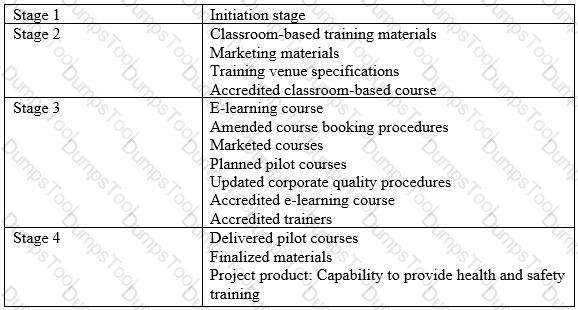
End of the Project scenario.
Additional Information:
The Chief Executive Officer (CEO) founded the company five years ago. Under her leadership, ABC Company has grown quickly into a successful training company. It delivers a range of accredited professional training.
The Finance Director is also a founder member of ABC Company and is responsible for authorizing budgets for the Operations and Development Teams. She authorizes all large contracts personally.
The Purchasing Manager reports to the Finance Director and is responsible for managing and monitoring supplier contracts.
The Operations Director is responsible for the delivery off all training and for the training development budget. His department organizes courses, venues and trainers. They work with the Product and the Sales teams to provide a comprehensive training schedule. ABC Company’s IT manager reports to the Operations Director.
The Business Development Director has recently been appointed to identify new training needs and propose new products. She will work with the Operations. Director to ensure a cost-conscious approach and that appropriate development technologies are used for the health and safety course.
The Training Development Manager reports to the Business Development Director and is responsible for developing training materials and gaining accreditation, in accordance with the standard course development model. Course developers in his team have skills in a range of development technologies and are allocated to projects as needed.
The Training Delivery Manager, who reports to the Operations Director, is responsible for ensuring that internal and external trainers deliver ABC Company training courses to the required standard. He also checks course materials to ensure they are fit for purpose and of the required quality.
The Central Services Director has responsibility for corporate communications, facilities management and configuration management. He recently led a project to consolidate all company quality systems into one quality management system and set up a corporate quality department, now managed by the Corporate Quality Manager.
The Corporate Document Manager reports to the Central Services Director. She helped establish the company’s document management system and now operates it across the business. She manages a team of administrators and contracts staff when workload is high.
The Sales Director joined ABC Company two months ago and is keen to establish himself by suggesting new markets for the courses and material. All account managers and the marketing team report to him. They promote existing training courses to other training companies and existing customers.
End of the additional information.
The government agency held a seminar for training organizations to discuss the approach to accreditation for new health and safety courses. The project manager attended on behalf of ABC Company. Other training organizations described delays that had occurred when accrediting course material in the past. As a result, the project manager has produced a report recommending ways to improve the 'classroom-based training materials' to avoid such delays.
Is this an appropriate application of the principle 'learn from experience', and why?
Project Scenario – Health and Safety Training Project:
ABC Company is a well-established training company that uses a standard model to develop training materials and deliver courses to customers.
ABC Company has commissioned a project in response to recent changes in government legislation relating to health and safety on construction sites. The project will deliver “capability to provide health and safety training”, including the materials needed for classroom-based training and e-learning. The expected benefits for construction companies include a reduction in lost days and legal costs due to accidents.
The e-learning course will be developed by a specialist external consultancy. The materials for classroom-based training will be delivered by ABC Company’s development team. All course materials will be piloted before they are used. ABC Company will deliver training to its customers and also hopes to sell the course materials to other training companies as part of their operational business. ABC Company will use their own sales and marketing departments to promote the courses.
The legislation requires construction companies to comply with the new legislation within two years. The course materials and trainers have to be accredited by a government agency before courses can be delivered. ABC Company is planning to deliver pilot courses within five months of starting the project.
The ABC Company standard development model for new courses recommends the following stages:
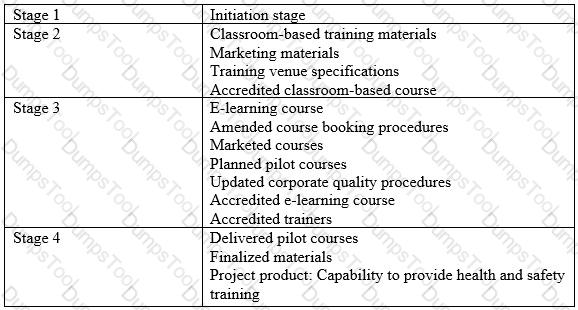
End of the Project scenario.
Additional Information:
The Chief Executive Officer (CEO) founded the company five years ago. Under her leadership, ABC Company has grown quickly into a successful training company. It delivers a range of accredited professional training.
The Finance Director is also a founder member of ABC Company and is responsible for authorizing budgets for the Operations and Development Teams. She authorizes all large contracts personally.
The Purchasing Manager reports to the Finance Director and is responsible for managing and monitoring supplier contracts.
The Operations Director is responsible for the delivery off all training and for the training development budget. His department organizes courses, venues and trainers. They work with the Product and the Sales teams to provide a comprehensive training schedule. ABC Company’s IT manager reports to the Operations Director.
The Business Development Director has recently been appointed to identify new training needs and propose new products. She will work with the Operations. Director to ensure a cost-conscious approach and that appropriate development technologies are used for the health and safety course.
The Training Development Manager reports to the Business Development Director and is responsible for developing training materials and gaining accreditation, in accordance with the standard course development model. Course developers in his team have skills in a range of development technologies and are allocated to projects as needed.
The Training Delivery Manager, who reports to the Operations Director, is responsible for ensuring that internal and external trainers deliver ABC Company training courses to the required standard. He also checks course materials to ensure they are fit for purpose and of the required quality.
The Central Services Director has responsibility for corporate communications, facilities management and configuration management. He recently led a project to consolidate all company quality systems into one quality management system and set up a corporate quality department, now managed by the Corporate Quality Manager.
The Corporate Document Manager reports to the Central Services Director. She helped establish the company’s document management system and now operates it across the business. She manages a team of administrators and contracts staff when workload is high.
The Sales Director joined ABC Company two months ago and is keen to establish himself by suggesting new markets for the courses and material. All account managers and the marketing team report to him. They promote existing training courses to other training companies and existing customers.
End of the additional information.
INITIATING A PROJECT
Here are three statements that were considered by the project management team during the ‘initiating a project’ process.
As part of which activity (A-F) should they FIRST be considered?
Choose only one activity for each statement. Each activity can be used once, more than once, or not at all.
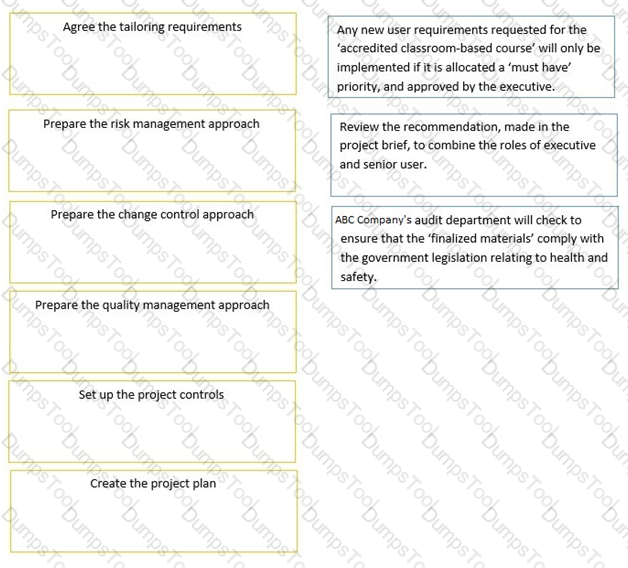
Project Scenario – Health and Safety Training Project:
ABC Company is a well-established training company that uses a standard model to develop training materials and deliver courses to customers.
ABC Company has commissioned a project in response to recent changes in government legislation relating to health and safety on construction sites. The project will deliver “capability to provide health and safety training”, including the materials needed for classroom-based training and e-learning. The expected benefits for construction companies include a reduction in lost days and legal costs due to accidents.
The e-learning course will be developed by a specialist external consultancy. The materials for classroom-based training will be delivered by ABC Company’s development team. All course materials will be piloted before they are used. ABC Company will deliver training to its customers and also hopes to sell the course materials to other training companies as part of their operational business. ABC Company will use their own sales and marketing departments to promote the courses.
The legislation requires construction companies to comply with the new legislation within two years. The course materials and trainers have to be accredited by a government agency before courses can be delivered. ABC Company is planning to deliver pilot courses within five months of starting the project.
The ABC Company standard development model for new courses recommends the following stages:
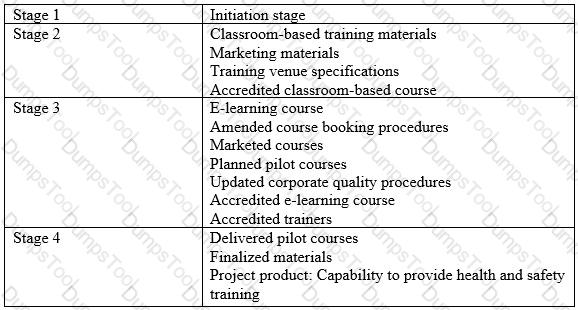
End of the Project scenario.
Additional Information:
The Chief Executive Officer (CEO) founded the company five years ago. Under her leadership, ABC Company has grown quickly into a successful training company. It delivers a range of accredited professional training.
The Finance Director is also a founder member of ABC Company and is responsible for authorizing budgets for the Operations and Development Teams. She authorizes all large contracts personally.
The Purchasing Manager reports to the Finance Director and is responsible for managing and monitoring supplier contracts.
The Operations Director is responsible for the delivery off all training and for the training development budget. His department organizes courses, venues and trainers. They work with the Product and the Sales teams to provide a comprehensive training schedule. ABC Company’s IT manager reports to the Operations Director.
The Business Development Director has recently been appointed to identify new training needs and propose new products. She will work with the Operations. Director to ensure a cost-conscious approach and that appropriate development technologies are used for the health and safety course.
The Training Development Manager reports to the Business Development Director and is responsible for developing training materials and gaining accreditation, in accordance with the standard course development model. Course developers in his team have skills in a range of development technologies and are allocated to projects as needed.
The Training Delivery Manager, who reports to the Operations Director, is responsible for ensuring that internal and external trainers deliver ABC Company training courses to the required standard. He also checks course materials to ensure they are fit for purpose and of the required quality.
The Central Services Director has responsibility for corporate communications, facilities management and configuration management. He recently led a project to consolidate all company quality systems into one quality management system and set up a corporate quality department, now managed by the Corporate Quality Manager.
The Corporate Document Manager reports to the Central Services Director. She helped establish the company’s document management system and now operates it across the business. She manages a team of administrators and contracts staff when workload is high.
The Sales Director joined ABC Company two months ago and is keen to establish himself by suggesting new markets for the courses and material. All account managers and the marketing team report to him. They promote existing training courses to other training companies and existing customers.
End of the additional information.
DIRECTING A PROJECT
Here are three actions that are carried out as part of the ‘directing a project’ process.
During which activity (A-E) should they be carried out?
Choose only one activity for each action. Each activity can be used once, more than once, or not at all.
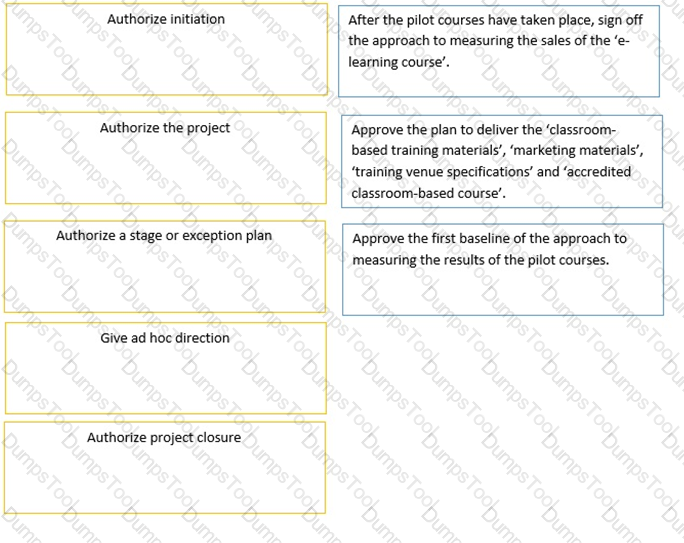
Project Scenario – Health and Safety Training Project:
ABC Company is a well-established training company that uses a standard model to develop training materials and deliver courses to customers.
ABC Company has commissioned a project in response to recent changes in government legislation relating to health and safety on construction sites. The project will deliver “capability to provide health and safety training”, including the materials needed for classroom-based training and e-learning. The expected benefits for construction companies include a reduction in lost days and legal costs due to accidents.
The e-learning course will be developed by a specialist external consultancy. The materials for classroom-based training will be delivered by ABC Company’s development team. All course materials will be piloted before they are used. ABC Company will deliver training to its customers and also hopes to sell the course materials to other training companies as part of their operational business. ABC Company will use their own sales and marketing departments to promote the courses.
The legislation requires construction companies to comply with the new legislation within two years. The course materials and trainers have to be accredited by a government agency before courses can be delivered. ABC Company is planning to deliver pilot courses within five months of starting the project.
The ABC Company standard development model for new courses recommends the following stages:
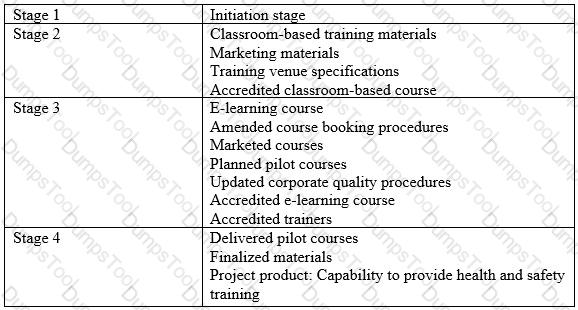
End of the Project scenario.
Additional Information:
The Chief Executive Officer (CEO) founded the company five years ago. Under her leadership, ABC Company has grown quickly into a successful training company. It delivers a range of accredited professional training.
The Finance Director is also a founder member of ABC Company and is responsible for authorizing budgets for the Operations and Development Teams. She authorizes all large contracts personally.
The Purchasing Manager reports to the Finance Director and is responsible for managing and monitoring supplier contracts.
The Operations Director is responsible for the delivery off all training and for the training development budget. His department organizes courses, venues and trainers. They work with the Product and the Sales teams to provide a comprehensive training schedule. ABC Company’s IT manager reports to the Operations Director.
The Business Development Director has recently been appointed to identify new training needs and propose new products. She will work with the Operations. Director to ensure a cost-conscious approach and that appropriate development technologies are used for the health and safety course.
The Training Development Manager reports to the Business Development Director and is responsible for developing training materials and gaining accreditation, in accordance with the standard course development model. Course developers in his team have skills in a range of development technologies and are allocated to projects as needed.
The Training Delivery Manager, who reports to the Operations Director, is responsible for ensuring that internal and external trainers deliver ABC Company training courses to the required standard. He also checks course materials to ensure they are fit for purpose and of the required quality.
The Central Services Director has responsibility for corporate communications, facilities management and configuration management. He recently led a project to consolidate all company quality systems into one quality management system and set up a corporate quality department, now managed by the Corporate Quality Manager.
The Corporate Document Manager reports to the Central Services Director. She helped establish the company’s document management system and now operates it across the business. She manages a team of administrators and contracts staff when workload is high.
The Sales Director joined ABC Company two months ago and is keen to establish himself by suggesting new markets for the courses and material. All account managers and the marketing team report to him. They promote existing training courses to other training companies and existing customers.
End of the additional information.
A quality review of the ‘marketing materials’ has started. The team manager for the ‘marketing materials’ has been unhappy with the team’s workload throughout the project and refuses to attend the review meeting to present the material. The team manager suggests that a new marketing team member make the presentation. However, the chair decides to represent the marketing team and makes a list of actions to resolve later.
Is this an appropriate approach to the quality review, and why?
Project Scenario – Health and Safety Training Project:
ABC Company is a well-established training company that uses a standard model to develop training materials and deliver courses to customers.
ABC Company has commissioned a project in response to recent changes in government legislation relating to health and safety on construction sites. The project will deliver “capability to provide health and safety training”, including the materials needed for classroom-based training and e-learning. The expected benefits for construction companies include a reduction in lost days and legal costs due to accidents.
The e-learning course will be developed by a specialist external consultancy. The materials for classroom-based training will be delivered by ABC Company’s development team. All course materials will be piloted before they are used. ABC Company will deliver training to its customers and also hopes to sell the course materials to other training companies as part of their operational business. ABC Company will use their own sales and marketing departments to promote the courses.
The legislation requires construction companies to comply with the new legislation within two years. The course materials and trainers have to be accredited by a government agency before courses can be delivered. ABC Company is planning to deliver pilot courses within five months of starting the project.
The ABC Company standard development model for new courses recommends the following stages:
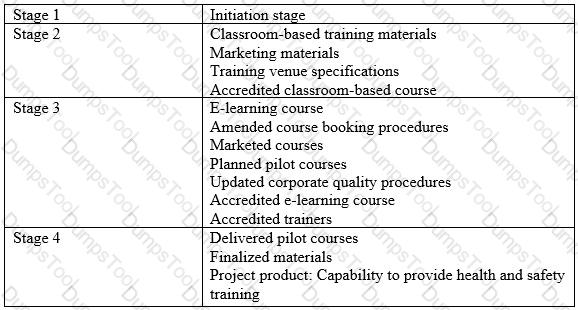
End of the Project scenario.
Additional Information:
The Chief Executive Officer (CEO) founded the company five years ago. Under her leadership, ABC Company has grown quickly into a successful training company. It delivers a range of accredited professional training.
The Finance Director is also a founder member of ABC Company and is responsible for authorizing budgets for the Operations and Development Teams. She authorizes all large contracts personally.
The Purchasing Manager reports to the Finance Director and is responsible for managing and monitoring supplier contracts.
The Operations Director is responsible for the delivery off all training and for the training development budget. His department organizes courses, venues and trainers. They work with the Product and the Sales teams to provide a comprehensive training schedule. ABC Company’s IT manager reports to the Operations Director.
The Business Development Director has recently been appointed to identify new training needs and propose new products. She will work with the Operations. Director to ensure a cost-conscious approach and that appropriate development technologies are used for the health and safety course.
The Training Development Manager reports to the Business Development Director and is responsible for developing training materials and gaining accreditation, in accordance with the standard course development model. Course developers in his team have skills in a range of development technologies and are allocated to projects as needed.
The Training Delivery Manager, who reports to the Operations Director, is responsible for ensuring that internal and external trainers deliver ABC Company training courses to the required standard. He also checks course materials to ensure they are fit for purpose and of the required quality.
The Central Services Director has responsibility for corporate communications, facilities management and configuration management. He recently led a project to consolidate all company quality systems into one quality management system and set up a corporate quality department, now managed by the Corporate Quality Manager.
The Corporate Document Manager reports to the Central Services Director. She helped establish the company’s document management system and now operates it across the business. She manages a team of administrators and contracts staff when workload is high.
The Sales Director joined ABC Company two months ago and is keen to establish himself by suggesting new markets for the courses and material. All account managers and the marketing team report to him. They promote existing training courses to other training companies and existing customers.
End of the additional information.
One of the senior managers of the company that is developing the ‘e-learning course’ has worked with ABC Company before. The team manager for the delivery of the ‘e-learning course’ has looked on ABC Company’s intranet, but cannot find any reference to this work. The team manager has contacted the senior manager to discuss this project.
Is this an appropriate application of the ‘learn from experience’ principle, and why?
Scenario
Additional Information
Product Description
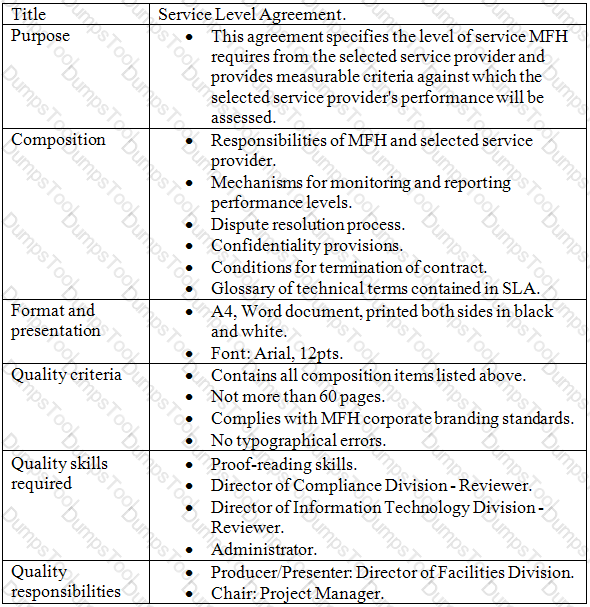
Quality notes from the Daily Log
The Director of Information Technology Division (DIT) has been asked to ensure that any changes to the outsourced staff employment contracts adhere to employment law. The DIT will review future job descriptions of the transferred staff before the final contract is signed with the selected service provider.
The service level agreement between MFH and the selected service provider will specify the type and quality of service required. The selected service provider must follow the industry standards for providing outsourced services.
MFH has a quality management system which contains a document control procedure for all its documentation, however this does not include change management.
All project documents will be subject to a quality review. Nominated products will require a formal approval record signed-off by the quality review chair.
Extract from the draft Quality Management Strategy (may contain errors)
Introduction
1. This document defines the approach to be taken to achieve the required quality levels during the project.
2. The Project Board will have overall responsibility for the Quality Management Strategy.
3. Project Assurance will provide assurance on the implementation of the Quality Management Strategy.
Quality management procedure - Quality standards
4. The selected service provider will operate to industry standards for providing outsourced services.
5. MFH document standards will be used.
Records
6. A Quality Register will be maintained to record the planned quality events and the actual results from the quality activities.
7. Configuration Item Records will be maintained for each product to describe its status, version and variant.
8. Approval records for products that require them will be stored in the quality database.
Roles and responsibilities
9. The DIT will check that the employment contracts for outsourced staff adhere to employment law.
10. Team Managers will provide details of quality checks that have been carried out.
11. Team Managers will ensure that the Quality Register is updated with the names of team members who are involved in the review process.
12. The Senior User will review the Product Descriptions of the products to be produced by the selected service provider to ensure that they can be achieved.
Which statement applies to the Introduction section?
Extract from the Project Product Description (with errors)
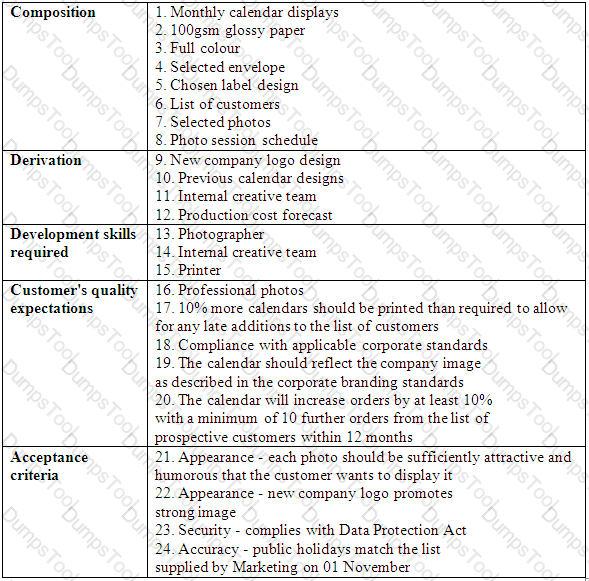
Column 1 is a list of objectives. For each objective in Column 1, select from Column 2 the quality activity that addresses it. Each selection from Column 2 can be used once, more than once or not at all. Drop down the right answer.
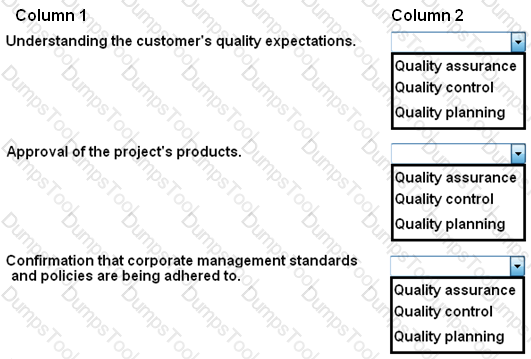
Which role is responsible for providing the customer's quality expectations and acceptance criteria for the project?
Scenario
Additional Information
Product Description
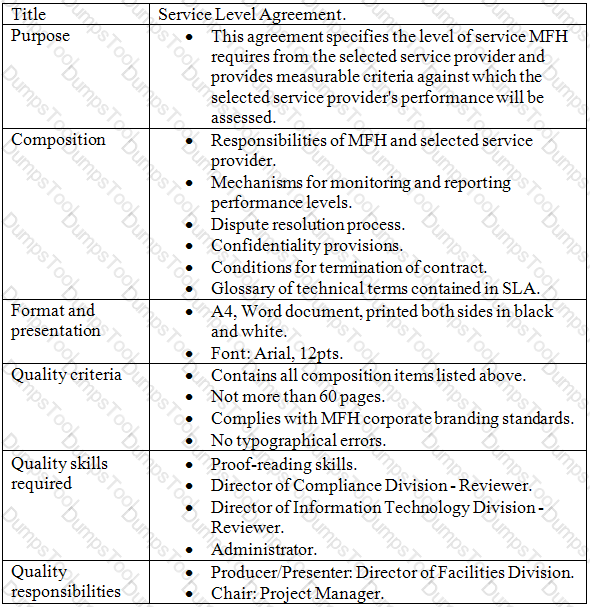
Quality notes from the Daily Log
The Director of Information Technology Division (DIT) has been asked to ensure that any changes to the outsourced staff employment contracts adhere to employment law. The DIT will review future job descriptions of the transferred staff before the final contract is signed with the selected service provider.
The service level agreement between MFH and the selected service provider will specify the type and quality of service required. The selected service provider must follow the industry standards for providing outsourced services.
MFH has a quality management system which contains a document control procedure for all its documentation, however this does not include change management.
All project documents will be subject to a quality review. Nominated products will require a formal approval record signed-off by the quality review chair.
Extract from the draft Quality Management Strategy (may contain errors)
Introduction
1. This document defines the approach to be taken to achieve the required quality levels during the project.
2. The Project Board will have overall responsibility for the Quality Management Strategy.
3. Project Assurance will provide assurance on the implementation of the Quality Management Strategy.
Quality management procedure - Quality standards
4. The selected service provider will operate to industry standards for providing outsourced services.
5. MFH document standards will be used.
Records
6. A Quality Register will be maintained to record the planned quality events and the actual results from the quality activities.
7. Configuration Item Records will be maintained for each product to describe its status, version and variant.
8. Approval records for products that require them will be stored in the quality database.
Roles and responsibilities
9. The DIT will check that the employment contracts for outsourced staff adhere to employment law.
10. Team Managers will provide details of quality checks that have been carried out.
11. Team Managers will ensure that the Quality Register is updated with the names of team members who are involved in the review process.
12. The Senior User will review the Product Descriptions of the products to be produced by the selected service provider to ensure that they can be achieved.
Which statement applies to the Roles and responsibilities section?
Which activity is responsible for updating the stage plan with actual during Controlling a Stage?
Which statement best explains the purpose of Tailor to suit the project environment?
Which of the following principles uses Product Descriptions to provide clarity by defining each product's purpose, composition, derivation, format, quality criteria and quality method?
Two weeks after starting work the Team Manager noticed that each completed product had exceeded its estimated effort by around 10%. If this trend continues the Work Package will exceed its agreed cost tolerance of 5%.
Which 2 actions should the Team Manager take in response to this situation?
Which of the following statements is true of the business interest on the project?
Scenario
Additional Information
Chief Executive Officer (CEO): He started the company 25 years ago and knows his job very well. He injured his leg two years ago which has restricted his visits to the engineering area. As CEO he has an overall perspective of the business strategic requirements and the authority to commit resources as required.
Marketing Director: She has been with the company for three years, following a successful career with a publicity company. She has the ability to represent the needs of the business, particularly as this is a marketing project. She has the authority to commit the annual business marketing budget, from which the project will be funded, as she sees appropriate. She will be responsible for monitoring the expected benefits of the calendar, in particular the improvement of the company's image.
Engineering Manager: He has been responsible for many engineering innovations in the company and is still as keen and energetic as the day he started. VVhilst he will not be part of the project team, his staff will feature in the photos for the promotional calendar.
Central Records: This group of five staff looks after all company records and document control. They now maintain all project files.
Bright Lights: This is the local office supplies company. It supplies all the stationery and office equipment needs of the company and will supply the stationery for this project.
Portraits ltd: This is a professional photographic company with a number of excellent photographers and a history of successful work. This company has been selected to take the photos for the company calendar. It has yet to be decided which of the photographers to use.
Which 2 statements explain why Central Records should be appointed as Project Support for this project?
Who is responsible for ensuring that Communication Management Strategy is appropriate and that planned communication activities actually take place?
Scenario
Additional Information
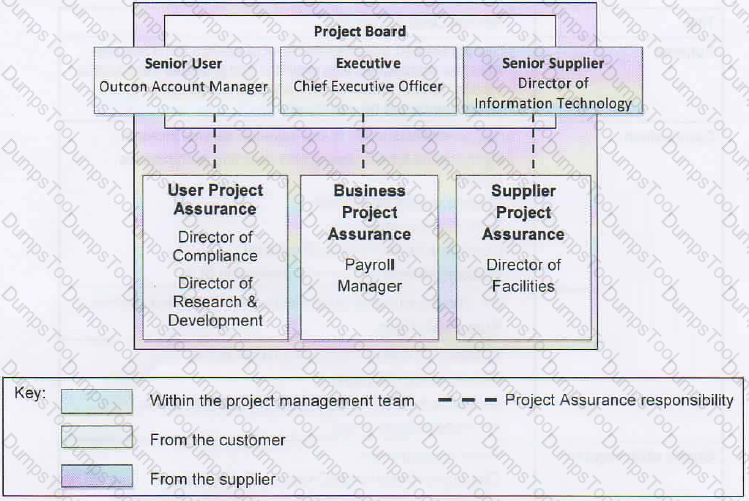
Further information on some resources who could be involved in the project:
Outcome Account Manager: He represents Outcome which is a recruitment agency that provides specialist outsourcing resources. Outcome provided the consultants who carried out the feasibility study and the same consultants will be providing support and guidance to the Information Technology and Facilities teams during the project.
Director of Finance Division: She was transferred from the Information Technology Division 12 months ago. She is responsible for ensuring a cost-conscious approach is adopted in all operational and project activities across the Ministry of Food Hygiene.
Hardware Manager: Reports to the Director of Information Technology. He provides computer hardware to all business functions but has little awareness of the needs of his colleagues working in software.
Payroll Manager: Reports to the Director of Finance. He is a very experienced and efficient qualified accountant who has much of the responsibility of running the Finance Division on behalf of the Director of Finance. He has been involved in drafting the Ministry's business strategy and assisting in a full business risk assessment. He also drafted the corporate Business Case standards.
Which 2 alternative actions apply to the proposed Senior Supplier for this project?
Scenario:
The Ministry of Food Hygiene (MFH) has a quality management system which contains a document control process to manage all documentation requirements. The document control process was created by the MFH Quality Manager, who now maintains all of MFH's documents and performs an organization-wide configuration management role. The MFH Quality Manager will administer the configuration management procedure for the Restructuring project since this must comply with the MFH document control process.
According to PRINCE2, which statement about appointing the MFH Quality Manager to administer the configuration management procedure is correct?
Scenario:
The Ministry of Food Hygiene (MFH) has a quality management system which contains a document control process to manage all documentation requirements. The document control process was created by the MFH Quality Manager, who now maintains all of MFH's documents and performs an organization-wide configuration management role. The MFH Quality Manager will administer the configuration management procedure for the Restructuring project since this must comply with the MFH document control process.
What will be the impact on the benefits?
Scenario:
Techniques, processes and procedures
1. Any threat that may result in a loss of MFH data must be escalated immediately.
Joint agreements
2. Work is to start at the beginning of week 2 (Stage 4).
3. The project will take two years to complete, at an estimated cost of £2.5m.
Tolerances
4. None.
Constraints
5. MFH staff must not be involved in any heavy lifting during the removal of existing IT equipment.
6. Installation work must take place during MFH normal working hours.
7. +£10,000 / -£25,000.
Reporting arrangements
8. Highlight Report every Monday by 10.00 am.
9. The report must contain a summary of all products worked on during the previous week.
10. Project Manager must be notified of any issues immediately by telephone.
Problem handling and escalation
11. Impact analysis of all issues must be completed within 24 hours.
Extracts or references
12. The Stage Plan for stage 4 is available from Project Support.
Approval method
13. Project Assurance will review the completed Work Package and confirm completion
Column 1 is a list of actions that occur during the Controlling a Stage process. For each action in Column 1, select from Column 2 the PRINCE2 theme that is being applied. Each selection from Column 2 can be used once, more than once or not at all.
Drop down the answer from column 1 to column 2.
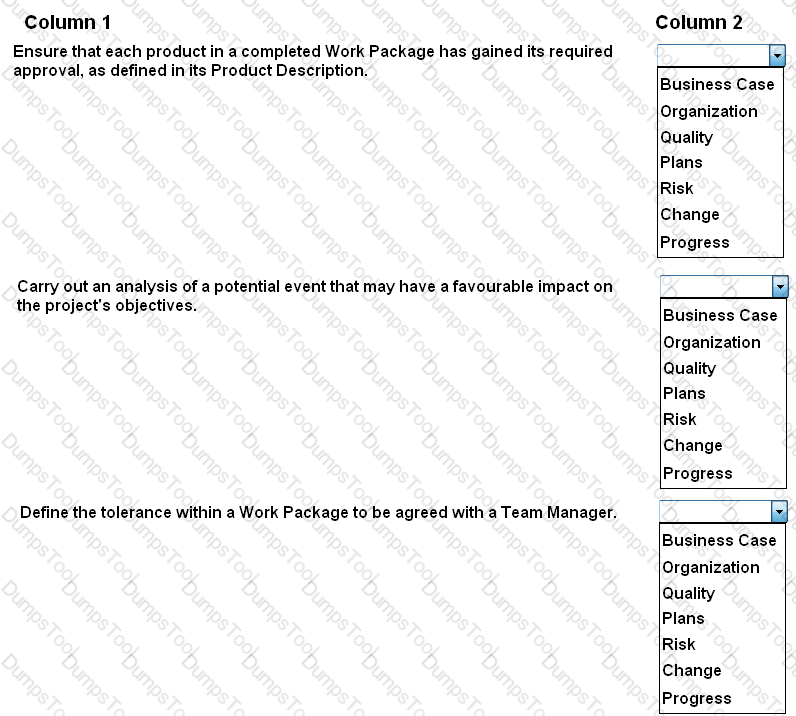
Which of the following activities is NOT an action of preparing for planned closure?
Project Scenario
Calendar Project (Note: The companies and people within the scenario are fictional.)
There has been a reduction in fie number of orders at the MNO Manufacturing Company due in part to the increased marketing activities of its competitors. To help counter this, the company has decided to create a promotional calendar for next year for all its current and prospective customers. The end product of this project will be a prepared calendar pack, ready for printing. The design of the calendar will be similar to one sent out previously, and must reflect the company image as described in the existing corporate branding standards. Another project is currently producing a new company logo when is to be printed on each page of the promotional calendar. The prepared calendar pack will consist of:
The project is currently in initiation and will have two further stages:
Stage 2 will include tie activities to:
Stage 3 will include the activities to:
A production cost forecast, based on the options and costs for the paper, envelope, printing and marketing of the calendar is to be produced in stage 2. However, the actual production and distribution of the calendars is not within the scope of the project. The product cost forecast will be reviewed by the Project Board to determine whether tie project should continue.
It is now 05 October and the prepared calendar pack must be delivered to the print company by 30 November, to enable printing and distribution of the calendar in time for Christmas. The cost of the activities to develop the specialist products and the cost of the project management activities are estimated to be £20,000. There is a project time tolerance of +1 week /-2 weeks and a project cost tolerance of +£6,000 / -£6,000. A change budget of £500 has been allocated but there is no risk budget.
During stage 2, an early review of the photo design ideas from the Marketing department has highlighted the need for engineering machinery to be operating in the background during the photo sessions. This requires a change to the baselined Product Description for the photos. What action should the Project Manager take?
Scenario
Additional Information
During the initiation stage the Project Manager met with the Marketing Director to find out more about the requirements of the promotional calendar and recorded the following notes:
There has been a reduction in the order numbers at the MNO Manufacturing due in part to the increased marketing activities of its competitors. 10% of customers have not re-ordered in this financial year and staff morale is poor. A number of skilled staff have left as a result and replacement staff have not been recruited due to the reduced operation. If the project is successful, a recruitment campaign will be required to fill the existing staff vacancies and there may be a requirement for additional staff. Operational costs are likely to increase because skilled staff are expensive and difficult to find.
In financial terms, there were a total of 1,500 orders in the last financial year, each with an average profit of £2k. The Marketing department believes that sending a promotional calendar to our current and prospective customers would increase orders by at least 10% with a minimum of 10 further orders from the list of prospective customers within 12 months from the date of distribution.
The Marketing Director will be funding the project from the business marketing budget. She believes that the effect of a good company image portrayed by a successful calendar would last into a second year. She has forecast the same increase in orders for a second year and predicts that the annual employee satisfaction survey will show a measurable improvement in staff morale.
A number of alternatives were explored, including:
The calendar is seen as the favored option, as long as the company's competitors do not increase their marketing activity. Whilst the Marketing department wants a very high quality, glossy product, the project management team must be aware of the cost this will incur.
Using the Project Scenario and the additional Information provided for this question In the Scenario Booklet, answer the following question.
Which 2 statements should be recorded under the Timescale heading?